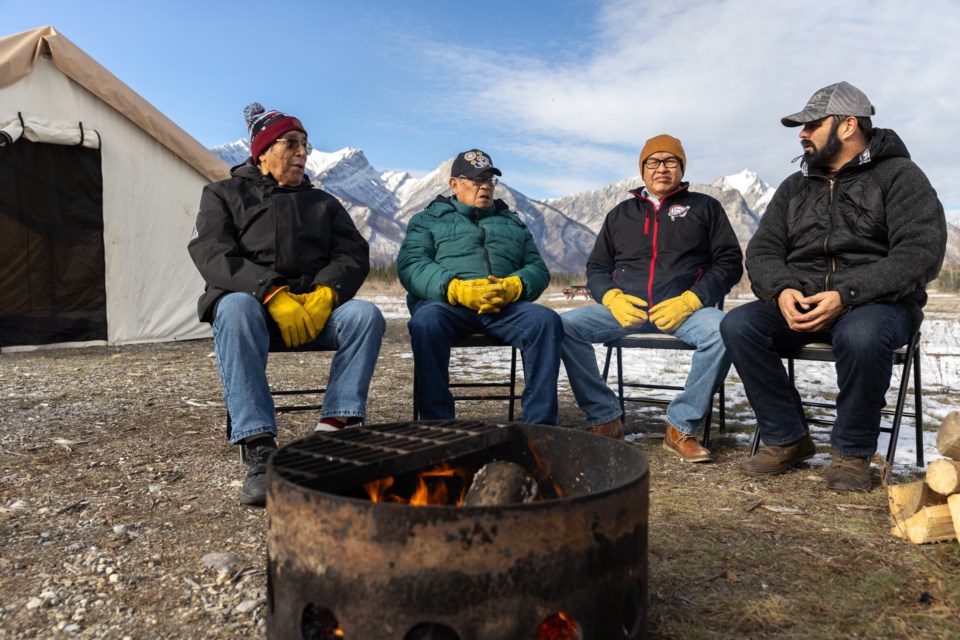JASPER NATIONAL PARK – The renewal of a historic agreement between two First Nations in Jasper National Park marks an enduring commitment to upholding treaty and aboriginal rights, and to continued Indigenous stewardship of the land.
In a weekend-long gathering (Oct. 27-29), Stoney Nation and Simpcw First Nation, supported by Parks Canada, renewed relationships that existed long before the formation of the national park through a ceremony and hunt.
“Our Nations have had a sacred treaty since time immemorial,” said Barry Wesley, a Stoney knowledge keeper who is part of the Jasper Indigenous Forum – an initiative that fosters collaboration between Parks staff, managers and Indigenous representatives with the shared goal of returning Indigenous presence and culture to the landscape.
“These are our traditional lands for hunting, ceremony and medicine-gathering. We would trade resources harvested from different sides of the mountains.”
Every four years, the Stoney Nation and Simpcw Nation – part of the Secwepemc Nation in B.C., would reconnect on the land of what is now known as Jasper to renew a time-honoured oral agreement – signed by a pipe ceremony. That was until the park was formed in 1907.
“That disrupted everything,” said Wesley. “But in spirit, the treaty was always alive.”
Parks Canada imposed regulations on the land with the intent of safeguarding wildlife and the environment, but these rules strictly prohibited any harvesting of animals or vegetation and forcibly removed Indigenous peoples from what became park-designated land.
“We had lived on these lands for thousands of years in harmony with nature and had food security for our communities,” said Simpcw Chief George Lampreau. “But under 150-200 years of colonial governments and systems put in place, our communities are now facing food security issues due to the poor management of forestry, of wildlife and fisheries.”
As part of the agreement renewal with the Stoney Nation, a hunting provision was included, in partnership with Parks.
What was harvested by both Nations – four elk, two deer and two bighorn sheep – was taken back to their respective communities to be shared among the elderly, single mothers, and those otherwise unable to hunt.
Lampreau said, unfortunately, there were some who responded to news of the hunt with ignorance, overlooking the significance of the two Nations’ historic agreement and focusing solely on the hunt.
“We had some pretty nasty comments and Parks has been fielding some pretty racist comments because they allowed us to do this, but we’re exercising a right to the lands we once occupied,” he said.
“Education is the biggest part of this, really. We need to ensure we work together to educate the general public on what really happened, and aboriginal rights because we’re non-treaty bands in B.C.,” he added.
A section of the national park from north of Shalebanks Campground south to the Snaring River Campground was closed beginning Oct. 23. The harvest has since ended, but the area is set to re-open Nov. 13, according to a Parks Canada news release.
Jasper National Park superintendent Alan Kehler said the area did not include major trails or attractions but the decision was made to close it to ensure public safety.
The area chosen was the same area Simpcw First Nation returned to for a hunt in 2017.
“At that time, we looked at a variety of different areas that were meaningful for them, that had wildlife of interest to them, where’s there’s a place for people to camp and hold ceremony and also an area we could close relatively easily,” said Kehler.
“There’s a bunch of different aspects to why that area was chosen but the Snaring River is an important site for many First Nations.”
Kehler said the Stoney and Simpcw Nations reached out to Parks Canada to support the historic gathering in the national park.
“Across the country, Parks Canada’s been working to restore connections between First Nations, Métis, Inuit communities and groups with traditional territories which they lived and hunted and gathered and met,” he said.
“What transpired in Jasper was just really an extension of that thinking and, again, trying to facilitate their gathering, their ceremony and facilitate that connection to the Jasper area.”
Wesley said this work has come a long way, but still has a long way to go.
Tired of “sneaking into her backyard for medicines,” Wesley said his late mother, who was a traditional healer, pushed her son to work toward allowing Stoney people back on the land to harvest and conduct ceremony.
Collaborating with Parks and Indigenous representatives, including Lampreau, Wesley’s efforts within the Jasper Indigenous Forum have played a vital role in reviving access to various land-based traditions.
Before his mother passed, Wesley said she was able to harvest medicinal ingredients and be part of ceremony on the land once again, without secrecy.
“This made my mom happy,” he said.
The Local Journalism Initiative is funded by the Government of Canada. The position covers Îyârhe (Stoney) Nakoda First Nation and Kananaskis Country.



